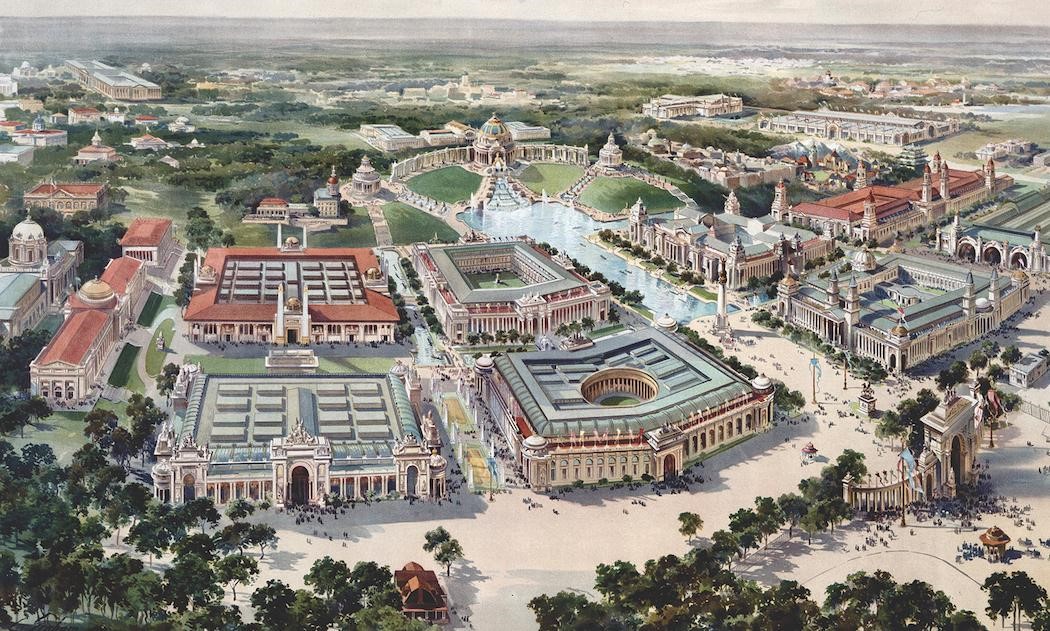
On a perfect spring day in late April – 120 years ago – 200,000 people witnessed the opening festivities of the 1904 World’s Fair in St. Louis amid a dazzling “Ivory City” of magnificent, massive palaces, cascading fountains and glittering lights.
The fair – officially named the Louisiana Purchase Exposition – welcomed 20 million visitors to Forest Park during its seven-month run, bringing the world to St. Louis and leading to a transformation for the city that continues to have impact today.

A new book, “Prelude to a Century: The 1904 St. Louis World’s Fair,” by author and longtime St. Louis television producer Patrick Murphy, takes readers inside the pomp and pageantry on full display for those who were there. It also offers a glimpse of the behind-the-scenes maneuvering, such as readying 1,200 acres of fairgrounds and ensuring the water from the fountains sparkled, all told from a modern, more nuanced mindset.
Calling the 1904 World’s Fair “a product of its time,” the book provides retrospective on the fair’s “noble aspirations and base prejudices –” even its naïveté when it came to acknowledging the struggles most St. Louisans faced at the turn of the century.
Gazelle editor-in-chief Trish Muyco-Tobin recently caught up with the author to discuss the continued interest surrounding the 1904 World’s Fair and how its significance plays out in the community today.

GAZELLE: YOU’VE PRODUCED DOCUMENTARIES AND WRITTEN QUITE EXTENSIVELY ABOUT ST. LOUIS AND ITS HISTORY OVER THE YEARS. WHAT WAS IT ABOUT THE 1904 WORLD’S FAIR THAT HELD FASCINATION FOR YOU?
PATRICK MURPHY (PM): Having grown up in St. Louis, I’ve heard stories of the fair all my life. My grandfather was a 12-year-old kid from Kerry Patch, working as a newsboy at the fair. It was a time when St. Louis was at the top of its game – the fourth-biggest city in America, holding the largest World’s Fair ever. The entire world was focused on our city, so it’s not hard to understand why we hold on to a picture of ourselves when we were young and attractive, and the whole world wanted to come and visit us. And over the past 120 years, families have passed stories and souvenirs through the generations. Of course, the park is still there, even though the palaces and cascades are gone, so with some imagination, it’s possible even today to stand on the crest of Art Hill and see the fair spread out before you. It’s like time traveling, which has always been a fantasy of mine.
GAZELLE: HOW LONG DID IT TAKE YOU TO WRITE THIS BOOK AND WHAT PROVED THE MOST CHALLENGING WHEN IT CAME TO PUTTING IT TOGETHER?
PM: The book took about a year to write. One of the interesting challenges was finding photographs and images that had never been seen before. The folks at the St. Louis Public Library and Missouri Historical Society (MHS) went out of their way to make their collections accessible to me. MHS actually brought up boxes of their undigitized materials for me to sift through and include in the book. That was a thrill, to see these photos and documents that were so rare.

GAZELLE: DURING YOUR RESEARCH FOR THE BOOK, DID YOU COME ACROSS ANYTHING THAT SURPRISED YOU?
PM: It surprised me that such a massive project could even be done in such a short period of time. In two years, the fair organizers cleared a forest, rerouted the River Des Peres, which ran through the park, built an entire city of ivory palaces, and then tore it down after eight months and restored it to the park we know today – all while attracting the major capitals of the world to participate in a city most of them had never heard of.
The inventions coming from the fair include the ice cream cone, the hot dog and cotton candy on the culinary side, but also wireless telegraphy, early versions of radio and fax machines, finger printing, and some of the earliest versions of automobiles and flying machines. I wanted to present the world of 1904 to readers in a way that would allow them to see the wonders of the fair in a similar way as the visitors who were actually there. We know how the 20th century turned out for all its good and bad, but in 1904, they were expecting a century of unlimited progress. We’re more wary of the future today. We’ve come to learn that technology has its flip side, a darker side.
GAZELLE: BASED ON WHAT WE NOW KNOW ABOUT THE “DARKER” SIDE OF THE FAIR, ESPECIALLY WHEN IT CAME TO EXPLOITING PEOPLE OF COLOR AND EXCLUDING CERTAIN GROUPS OF PEOPLE FROM ATTENDING, WHY DO YOU THINK IT TOOK MORE THAN 100 YEARS LATER FOR THE COMMUNITY AS A WHOLE TO COME TO A RECKONING?
PM: The organizers of the fair wore blinders when it came to race and ethnicity. Almost exclusively white, male and Euro-American, the presenters measured progress by their own standards, relegating Indigenous people to small villages or displays, often referred to today as “human zoos.” Though the fair was not officially segregated, it might as well have been for most African Americans looking for employment there or simply to be served at the various restaurants. When you venture into history, be careful – you’ll find everything from the glorious to the shameful, and each age has its blind spots. The chauvinism and racism is deplorable, but it’s an undeniable part of our story.
GAZELLE: THERE IS NO QUESTION THE FAIR HELPED SHAPE THE 20TH CENTURY FOR ST. LOUIS AND ITS RESIDENTS. WHAT ARE THE LINGERING INFLUENCES YOU SEE IN THE CITY A CENTURY LATER?
PM: To understand where we are today, we need to understand where we came from. The 1904 World’s Fair is an amazing opportunity to visit an event that was dedicated to presenting the world in the way that a lot of thought leaders understood it at the time. What an opportunity to see what they got right, what they got wrong and how far we’ve come. We think our world is complicated today, that 1904 was simpler – even quaint – but the people living in 1904 did not see it as simple at all. It was confusing and full of rapid change, and –like us – they were trying to understand it and live in it. In that sense, not that much has changed.

“Prelude to a Century: The 1904 St. Louis World’s Fair,” by Reedy Press, is available at bookstores and through online retailers.
An official book launch and signing takes place from 5 to 8 p.m. on Thursday, April 11 at the Missouri History Museum. (Coincidentally, the museum’s revamped 1904 World’s Fair exhibit opens to the public on April 27). The author has additional book signings planned, including at Webster Books (April 13), Main Street Books (April 14), Kerry Cottage (April 27) and Campbell House (April 28).





